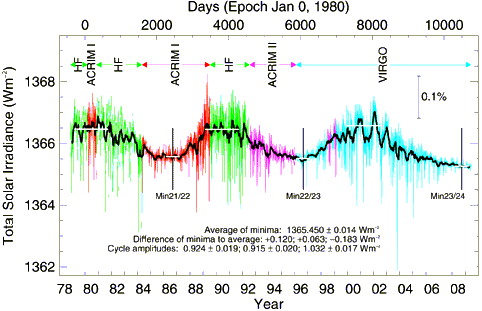
The luminosity of the Sun is around 3.86 x 1026 watts. This is the total power radiated out into space by the Sun. Most of this radiation is in the visible and infrared part of the electromagnetic spectrum, with less than 1 % emitted in the radio, UV and X-ray spectral bands. This energy is also radiated isotropically, that is, uniformly into space, independent of direction.
Because the Sun is about 150 million kilometres from the Earth, and because the Earth is about 6380 km in radius, only 0.000000045% of this power is intercepted by our planet. This still amounts to a massive 1.75 x 1017 watts. For the purposes of solar energy capture, we normally talk about the amount of power in sunlight passing through one square metre at the Earth's distance from the Sun (and that one square metre is assumed to be at normal incidence, or 'face on' to the direction from which the sunlight is coming). This power is termed the solar constant, and is approximately 1370 watts per square metre (W m-2).
Now this solar constant is actually not a true constant. It varies by +/- 3% because of the Earth's slightly elliptical orbit around the Sun, being larger when the Earth is at perihelion (currently in early January) and smaller when the Earth is at aphelion (currently in early July). Some people, when talking about the solar constant, correct for this distance variation, and refer to the solar constant as the power per unit area received at the average Earth-solar distance (one Astronomical Unit or AU which is 149.59787066 million kilometres).
However, there is another small variation in the solar 'constant', and that is due to a variation in the instrinsic luminosity of the Sun itself. This variation has been measured by radiometers aboard several satellites since the late 1970's. The graph below is a composite graph produced by the World Radiation Centre over the three decades of measurement and shows that our Sun is truly a (slightly) variable star.

The smoothed variation in the solar constant can be seen to be around 0.1% over a period of 30 years. There is a transient peak to peak variation of about 0.5%, but this only lasts for a very short time. Some researchers have tried to reconstruct this variation (by correlating it to sunspot numbers) back over the last 400 years, and have suggested that the Sun may have varied in its power output by up to one percent. It has also been suggested that this variation might explain some terrestrial temperature variations.
It is interesting to note that the average G-type star (the Sun is a class G2 star) typically shows a variation of about 4%. It is probably fortunate for us that our star does not show such a typical variability, as we might then well see temperature changes much greater than any so far predicted from anthropomorphic causes.